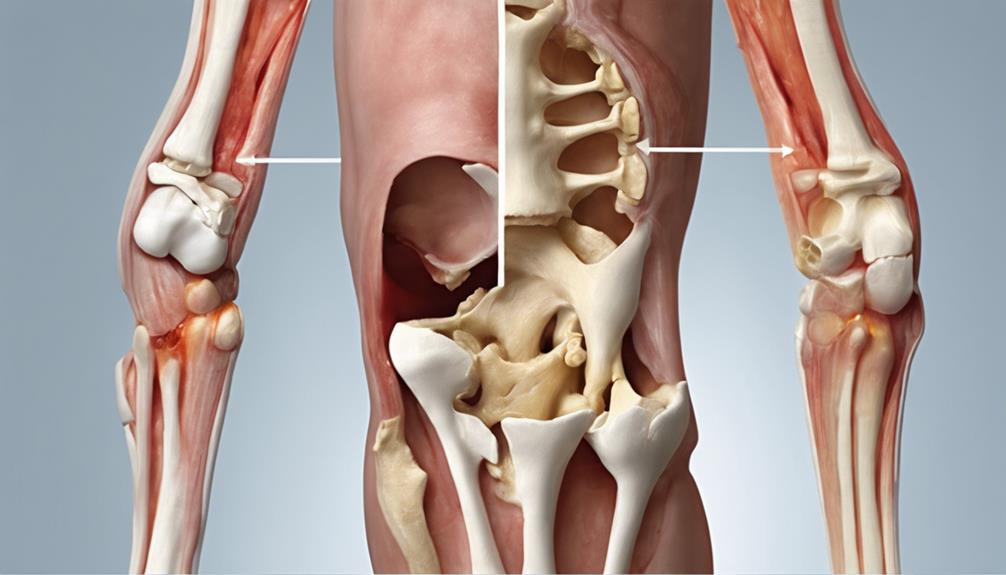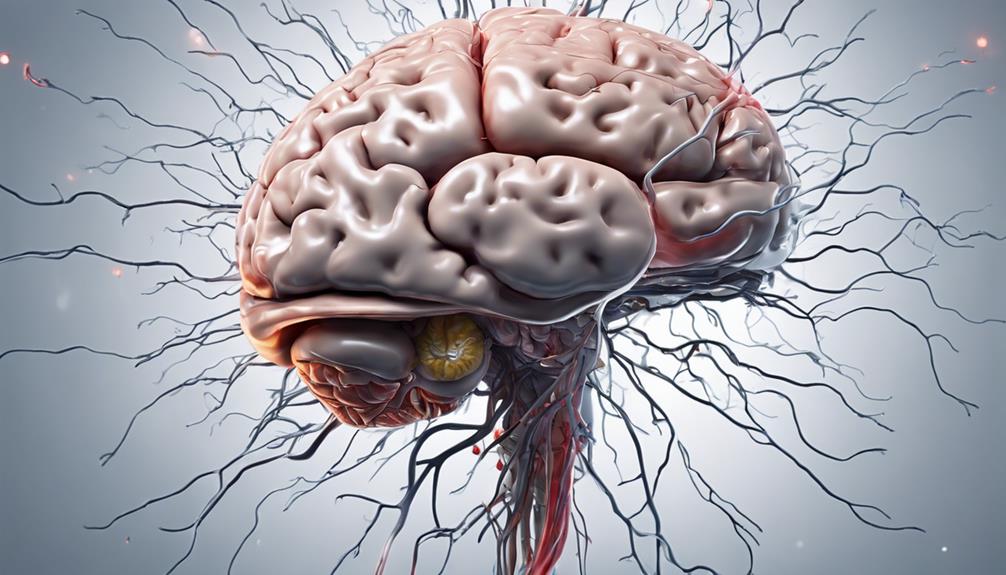In our journey through the difficult terrain of recovering from a cerebellar stroke, we come across a path filled with obstacles and successes.
The resilience of the human brain in adapting to adversity is a fascinating aspect that begs further contemplation.
The complexities of this recovery process and the strategies employed to navigate them reveal a depth of understanding that is both enlightening and essential.
Join us as we unravel the intricate tapestry of cerebellar stroke recovery, delving into the nuances that shape the path to healing and restoration.
Key Takeaways
- Customized rehabilitation programs crucial
- High intensity exercises aid recovery
- Consistent home therapy essential
- Utilize interactive home therapy devices
Challenges in Cerebellar Stroke Recovery
During the recovery process from cerebellar stroke, individuals often face significant challenges in balance, coordination, cognitive function, and motor skills. Cerebellar stroke can result in a range of deficits that impact daily activities and quality of life.
Balance and coordination difficulties are common after a cerebellar stroke, making simple tasks like walking or reaching for objects challenging. Cognitive impairments, such as memory problems and speech difficulties, can hinder rehabilitation progress and necessitate tailored interventions.
Persistent vertigo and dizziness post-stroke not only affect physical well-being but also impede the ability to engage effectively in rehabilitation programs. Motor learning deficits and proprioception issues further complicate recovery, requiring specialized strategies to regain movement control and stability.
Rehabilitation strategies need to be individualized to address these specific deficits comprehensively, promoting optimal recovery outcomes for individuals affected by cerebellar strokes.
Strategies for Effective Rehabilitation

In cerebellar stroke rehabilitation, implementing customized programs tailored to individual needs is paramount for optimizing recovery outcomes. These programs should include a combination of physical therapy, occupational therapy, speech therapy, and cognitive training to address the diverse needs of individuals post-cerebellar stroke. High intensity exercises play a crucial role in stimulating neuroplasticity, facilitating faster recovery. Understanding the severity of cerebellar stroke through the NIH Stroke Scale can guide the rehabilitation process effectively. Moreover, incorporating interactive home therapy devices like FitMi can enhance the rehabilitation experience by increasing repetitions and providing motivational auditory feedback. By tailoring rehabilitation programs to the specific needs of each individual and focusing on high intensity exercises, neuroplasticity, and utilizing home therapy devices, optimal recovery outcomes can be achieved.
| Rehabilitation Programs | Individualized Therapy | Home Therapy Devices |
|---|---|---|
| Physical Therapy | Occupational Therapy | FitMi |
| Speech Therapy | Cognitive Training |
Timeline for Cerebellar Stroke Recovery
Our understanding of the timeline for cerebellar stroke recovery underscores the significance of consistent and tailored rehabilitation efforts to optimize outcomes. Following a cerebellar stroke, recovery timelines can vary, with many individuals experiencing rapid improvements in the first 3-6 months due to heightened neuroplasticity. However, it's essential to note that recovery from a cerebellar stroke is an ongoing process. Consistent home therapy beyond the initial months is crucial, as a lack of therapy can lead to plateaus or even regressive progress in the recovery journey.
The severity of the stroke, as assessed by tools like the NIH Stroke Scale, plays a significant role in guiding rehabilitation efforts. Customized programs that consider the individual's needs and the intensity of rehabilitation are key factors in ensuring optimal recovery. The intensity of rehabilitation programs significantly influences recovery outcomes, highlighting the importance of sustained and consistent efforts in rehabilitation. Remember, the potential for ongoing improvement in cerebellar stroke recovery is vast, with dedication and appropriate rehabilitation measures being paramount.
Key Elements of Successful Recovery

To optimize cerebellar stroke recovery, prioritizing consistent and tailored rehabilitation programs is imperative. These programs should focus on high repetition and intensity in therapy exercises to engage neuroplasticity effectively.
Customized physical, occupational, and speech therapy are essential for enhancing motor skills and cognitive abilities in stroke survivors. Understanding the NIH Stroke Scale can offer valuable insights into the severity of the stroke, aiding in the development of personalized rehabilitation plans.
Additionally, utilizing interactive home therapy devices such as FitMi can be beneficial. These devices provide auditory feedback and motivation, facilitating stroke survivors' engagement in their recovery process.
Resources for Ongoing Support
For individuals seeking ongoing support in cerebellar stroke recovery, accessing resources like Flint Rehab's gamified neurorehab tools and free ebook on Full Body Exercises for Stroke Patients can be beneficial. These resources offer valuable guidance and tools for survivors and caregivers navigating the complexities of stroke recovery.
Flint Rehab's FitMi home therapy, known for its effectiveness in stroke recovery, provides auditory feedback for motivation and is utilized in top rehab clinics. Additionally, articles on various stroke recovery topics such as aphasia, foot drop, and arm exercises are available to offer further support and information.
The free stroke recovery ebook by Flint Rehab presents 15 tips tailored to survivors and caregivers seeking ongoing assistance. Interactive home therapy devices like FitMi facilitate high repetition and faster improvement specifically for cerebellar stroke recovery.
Frequently Asked Questions
Can You Recover From a Cerebellum Stroke?
Yes, we can recover from a cerebellum stroke. Recovery is possible with timely medical care and focused rehabilitation. The extent of recovery varies based on factors like stroke severity, age, and overall health.
Early treatment and consistent therapy significantly improve long-term outcomes. Understanding the impact of a cerebellar stroke on physical movements and cognition is crucial for effective recovery strategies.
What Is Life Expectancy After a Cerebellar Stroke?
Life expectancy after a cerebellar stroke can vary significantly based on individual factors like age, overall health, severity of the stroke, and timely medical intervention. Studies indicate a mortality rate of around 17% and poor outcomes for over 30% of individuals six months post-stroke.
Prompt medical care and rehabilitation are vital in improving life expectancy and recovery outcomes. Understanding the effects and implementing appropriate treatment can positively impact prognosis and quality of life.
What Are the Long-Term Effects of a Cerebellar Stroke?
We've noted that long-term effects of a cerebellar stroke encompass persistent ataxia, coordination difficulties, and balance impairments.
Cognitive affective syndrome, memory issues, and speech problems may persist post-stroke.
Survivors might experience ongoing vertigo, nausea, and eye movement disorders.
Proprioception difficulties and muscle weakness can impact daily activities in the long term.
Challenges with posture, motor learning, and overall mobility may persist for years following a cerebellar stroke.
What Causes a Cerebellum Stroke?
Cerebellar strokes, whether ischemic or hemorrhagic, usually arise from blockages or ruptures in blood vessels supplying this crucial brain region. Common arteries involved are like the anterior inferior cerebellar artery, impacting functions like balance and voluntary movements.
Symptoms can include vertigo, dizziness, nausea, vomiting, and increased intracranial pressure in hemorrhagic cases. Diagnosis is often challenging due to nonspecific symptoms, necessitating detailed medical history review and imaging tests for precise identification.
Conclusion
In conclusion, cerebellar stroke recovery requires a comprehensive rehabilitation approach to address motor control and coordination impairments.
Interestingly, studies have shown that individuals who engage in consistent and intensive therapy within the first three months post-stroke are more likely to experience significant improvements in their functional abilities.
This underscores the importance of early intervention and dedicated effort in achieving optimal recovery outcomes.









